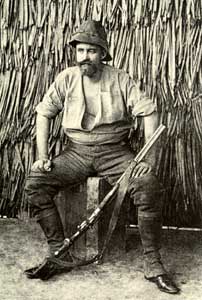Sámuel Teleki
Count Sámuel Teleki von Szék [ ˈʃaːmuɛl ˈtɛlɛki ] (born November 1, 1845 in Dumbrăvioara (Hungarian Sáromberke , Ger. Scharnberg , Transylvania , then Austrian Empire , now Romania ); † March 10, 1916 in Budapest ) was an Austro-Hungarian politician , Explorer and explorer.
Life

Sámuel Teleki, who came from an old Hungarian noble family, spent the first half of his life managing his family's estates and made a political career. In 1881 he became a member of the Magnate Board , the Hungarian upper house .
As a passionate hunter, fascinated by the travel reports of the great Africa explorers of his time, Teleki repeatedly toyed with the idea of daring an expedition to Africa . In 1886 the time had come: Teleki set out with his companion, Navy Lieutenant Ludwig von Höhnel , and followed a route that was already known by the British researcher Joseph Thomson . In 1887 they reached the foot of Kilimanjaro , which Teleki tried in vain to climb. They continued to Lake Baringo and then north, where they discovered a new lake, which they named Rudolfsee after the Crown Prince of Austria-Hungary . Another of Teleki's expedition results was the discovery of a second, smaller body of water, Lake Stefanie ; named after the Crown Princess.
Through the Turkana region , following the dried up riverbed of the Turkwels , the expedition finally reached Mombasa in October 1888 , from where they started their journey home via Zanzibar . On the return journey by ship, Teleki went ashore in the Gulf of Aden and explored the Ethiopian highlands, presumably to prepare a new expedition to the discovered sea areas, this time from the north. Teleki met the French poet Arthur Rimbaud in Harar , who had settled there as a trader. In a letter of February 25, 1889, Rimbaud writes (to Jules Borelli): A few days ago we had a visit from Count Téléki, who has made an important trip to the unexplored areas in northwestern Kenya: he says he will be south of until ten days Kaffa advanced. He told us again what you [Jules Borelli] say about the course of the Djibié, that is, that instead of flowing into the Indian Ocean, the river flows into a large lake to the southeast. […] Count Téléki travels back to Zeilah. The funeral services for Prince Rudolph call him back to Austria. In 1889 Teleki and Höhnel finally returned to Europe.
The fact that the expedition was not a great success despite Telekis' lavish equipment was mainly due to some amateurish mistakes. For example, the group wandered haphazardly through the area because all of the maps had been stolen from them in the first few days. In addition, there were frequent clashes with locals. During the expedition, 36 participants were killed and 34 deserted.
Teleki visited Kenya again in 1895 . However, his attempt to climb Kilimanjaro, which Ludwig Purtscheller and Hans Meyer had climbed for the first time, failed again.
Teleki then withdrew to his Hungarian estates until his death in 1916.
Carl Peters named a rock formation on the Uaso Nyiro River after Teleki as early as 1890 . In 2008 an asteroid was named after him: (163819) Teleki .
literature
- Eyelids of morning: the mingled destinies of crocodiles and men: being a description of the origins, history, and prospects of Lake Rudolf, its peoples, deserts, rivers, mountains and weather: a narrative of our investigations into the natural history, habits and mode of life of the fearsome Nyle crocodile, most formidable of reptiles, the legendary leviathan ... / Alistair Graham. A&W Visual Library, c1973
- Ludwig von Höhnel: "Discovery of Lakes Rudolf and Stefanie: a narrative of Count Samuel Teleki's exploring and hunting expedition in Eastern Equatorial Africa in 1887 and 1888"
Web links
- Samuel Graf Teleki (more detailed information about Teleki's first expedition)
- To the Jade Lake . Treatment of a documentary
| personal data | |
|---|---|
| SURNAME | Teleki, Sámuel |
| ALTERNATIVE NAMES | Teleki von Szék, Sámuel (full name) |
| BRIEF DESCRIPTION | Austro-Hungarian politician, explorer and explorer |
| DATE OF BIRTH | November 1, 1845 |
| PLACE OF BIRTH | Dumbrăvioara , Transylvania , Austrian Empire (now Romania ) |
| DATE OF DEATH | March 10, 1916 |
| Place of death | Budapest , Austria-Hungary |


